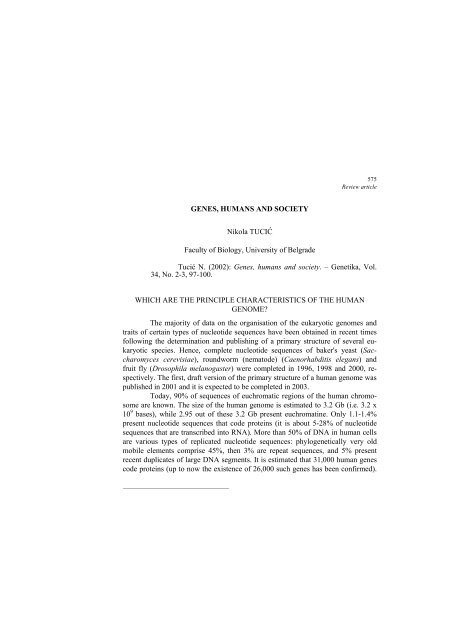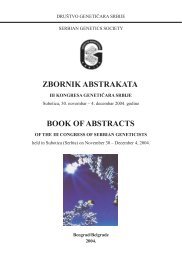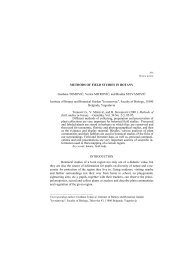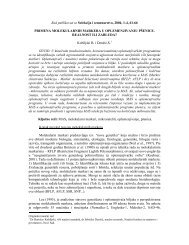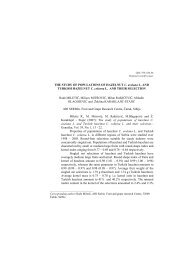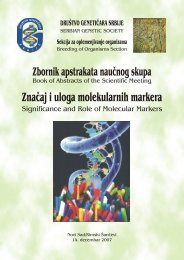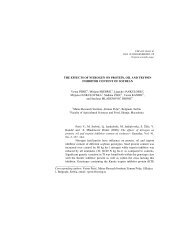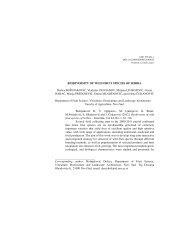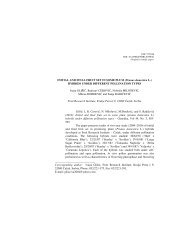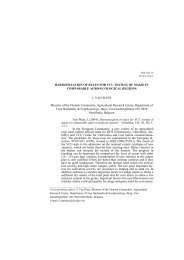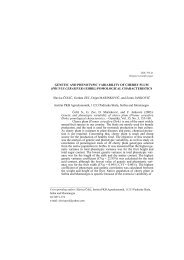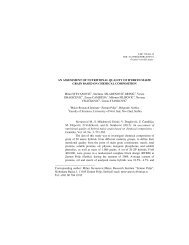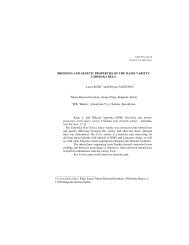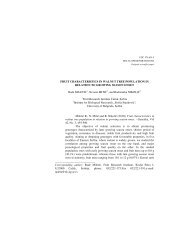Genes, humans and society
Genes, humans and society
Genes, humans and society
You also want an ePaper? Increase the reach of your titles
YUMPU automatically turns print PDFs into web optimized ePapers that Google loves.
GENES, HUMANS AND SOCIETY<br />
Nikola TUCIĆ<br />
Faculty of Biology, University of Belgrade<br />
575<br />
Review article<br />
Tucić N. (2002): <strong>Genes</strong>, <strong>humans</strong> <strong>and</strong> <strong>society</strong>. – Genetika, Vol.<br />
34, No. 2-3, 97-100.<br />
WHICH ARE THE PRINCIPLE CHARACTERISTICS OF THE HUMAN<br />
GENOME?<br />
The majority of data on the organisation of the eukaryotic genomes <strong>and</strong><br />
traits of certain types of nucleotide sequences have been obtained in recent times<br />
following the determination <strong>and</strong> publishing of a primary structure of several eukaryotic<br />
species. Hence, complete nucleotide sequences of baker's yeast (Saccharomyces<br />
cerevisiae), roundworm (nematode) (Caenorhabditis elegans) <strong>and</strong><br />
fruit fly (Drosophila melanogaster) were completed in 1996, 1998 <strong>and</strong> 2000, respectively.<br />
The first, draft version of the primary structure of a human genome was<br />
published in 2001 <strong>and</strong> it is expected to be completed in 2003.<br />
Today, 90% of sequences of euchromatic regions of the human chromosome<br />
are known. The size of the human genome is estimated to 3.2 Gb (i.e. 3.2 x<br />
10 9 bases), while 2.95 out of these 3.2 Gb present euchromatine. Only 1.1-1.4%<br />
present nucleotide sequences that code proteins (it is about 5-28% of nucleotide<br />
sequences that are transcribed into RNA). More than 50% of DNA in human cells<br />
are various types of replicated nucleotide sequences: phylogenetically very old<br />
mobile elements comprise 45%, then 3% are repeat sequences, <strong>and</strong> 5% present<br />
recent duplicates of large DNA segments. It is estimated that 31,000 human genes<br />
code proteins (up to now the existence of 26,000 such genes has been confirmed).<br />
_______________________________
98 GENETIKA, Vol. 34, No. 2-3, 97-100, 2002.<br />
On the other h<strong>and</strong>, approximately 6,000, 13,000, 18,000 <strong>and</strong> 26,000 genes, coding<br />
proteins, were detected in baker's yeast, platyhelminths, fruit fly <strong>and</strong> mouse-ear<br />
cress, respectively. Only 94 of 1278 (or 7.4%) of protein families are coded by<br />
human genes that are specific for vertebrates. It is estimated that 47 genes coding<br />
proteins were formed of mobile genetic elements, while 223 probably originated<br />
from bacteria, i.e. they are present in the human genome as a result of the horizontal<br />
evolution. Alternative intron excision is present in about 35% of genes. <strong>Genes</strong><br />
coding proteins in <strong>humans</strong> have small exons (about 50 codons) <strong>and</strong> very long introns<br />
(length of some of them is up to 10 kb).<br />
WHAT IS AN INNATE/ACQUIRED CONTROVERSY?<br />
Many discussions have been taken in psychology in relation to the roles of<br />
biological ("innate") <strong>and</strong> cultural ("acquired") factors in the formation of human<br />
behaviour. There are four approaches to this problem. 1. Biological determinism<br />
is the belief that individual biological differences, such as those related to neuroanatomy,<br />
hormones <strong>and</strong> finally genes, are responsible for all types of human behaviour.<br />
2. Social constructivism (syn. empiricism) on the other h<strong>and</strong>, emphasises<br />
the influences of cultural <strong>and</strong> social contexts in human behaviour. 3. Interactionism<br />
is believed to be a process of interaction of both biological <strong>and</strong> social factors<br />
that determine human behaviour. 4. The theory of developmental systems claims<br />
that any separation of innate from acquired is artificial, because all types of human<br />
behaviour are a result of a complex system within reactions whose parts cannot be<br />
treated as discrete units.<br />
WHAT ARE INNATE TRAITS?<br />
1. In the context of genotype-phenotype relation - for the majority of<br />
ethologists, psychologists <strong>and</strong> many geneticists the innateness of a certain trait is<br />
another term for the trait caused by genes. In other words, the trait is either "innate"<br />
or "acquired" if the development of the given organism is "closed" for environmental<br />
effects on the given trait. The innate or genetic traits are, according to this<br />
concept, "ontogenetically fixed", i.e. all pecies of information necessary for the<br />
development of the individual would be coded in its genotype. Many researchers,<br />
such as evolutionary physiologists <strong>and</strong> sociobiologists, who accept the concept of<br />
ontogenetic fixation are of the opinion that innate traits are always adaptations.<br />
Any modification of the "normal" environment (i.e. of the one for which adaptation<br />
is an innate trait) that would change the condition of the given trait would not represent<br />
a natural variability of a phenotype, i.e. phenotypic adaptability, but "abnormality"<br />
("aberration" or "pathological condition"). Furthermore, according to a<br />
famous ethologist Konrad Lorenz <strong>and</strong> his followers who support the concept of<br />
ontogenetic fixation of innateness, if a trait "requires" an environmental stimulus<br />
for its "natural development" under normal conditions it means that that trait is not<br />
an innate one. Therefore, the innate trait is a trait which is entirely determined by<br />
genes under normal conditions. For instance, children who had misfortune to grow
N:TUCIĆ: GENES, HUMANS AND SOCIETY 99<br />
up without a possibility to communicate with other people did not develop linguistic<br />
abilities (which indicates to the development of neurological components of the<br />
language <strong>and</strong> speech <strong>and</strong> to the fact that their functional conditions depend on<br />
stimuli coming form other people in early periods of the postnatal development);<br />
according to the concept of ontogenetic fixation, the language is not the innate trait<br />
in <strong>humans</strong>, although it is very clear that only they have genetically determined neural<br />
structures that establish the mode by which linguistic elements (such as words)<br />
are used to form rational sentences (syntax) regardless of the language itself. The<br />
concept of innateness based on ontogenetic fixation is in collision with the contemporary<br />
genetics, which has inevitably shown that all traits of an organism presented<br />
a result of interactions between genes <strong>and</strong> environments under which the<br />
development of the organism was conducted. In other words, both, genes <strong>and</strong> environments<br />
are causal factors for each trait of an organism.<br />
2. In the context of differences among population individuals - the original<br />
<strong>and</strong> fundamental meaning of the term "innate" or "genetic" trait in the contemporary<br />
biology is: a trait is "innate" one if phenotypic differences among individuals<br />
in a given population can be explained by genetic differences.<br />
WHICH ARE THE BASES OF THE CONTEMPORARY GENETIC<br />
DETERMINISM?<br />
The belief of the contemporary genetic determinism is that evolutionary<br />
biological considerations have a crucial role in underst<strong>and</strong>ing of our own selves,<br />
our behaviour <strong>and</strong> validation systems. It is claimed that social policy, legislation<br />
<strong>and</strong> ethical systems of human societies have to be within frames provided by the<br />
genetics. Culture is an epiphenomenon; it is said that the crown of the genetics can<br />
be used to "hide a reality from us". The human being is described as a selfish, aggressive<br />
creature that functions the best within a group which permits him without<br />
any limitation set by modern societies, to express absolutely freely his own biological<br />
instincts. The ambition of sociobiology <strong>and</strong> evolutionary psychology is<br />
greater than the "explanation" of human nature; it is an attempt to develop a total<br />
explanatory system of the human social existence.<br />
WHAT IS THE EVOLUTIONARY PSYCHOLOGY?<br />
The majority of people encountering the term "evolutionary psychology"<br />
thinks of it as a discipline relating to studies on the evolution of cognitive abilities<br />
<strong>and</strong> behaviour. However, over the last ten years, the evolutionary psychology have<br />
been developing into a specific research programme based on very explicit nativistic<br />
<strong>and</strong> adaptive interpretations of evolutionary mechanisms exclusively related to<br />
human mental abilities <strong>and</strong> behaviour. There are several essential principles characteristic<br />
for this research programme. The majority of evolutionary psychologists<br />
<strong>and</strong> anthropologists believes that aspects of human behaviour, traditionally studied<br />
by the psychology <strong>and</strong> anthropology, can <strong>and</strong> have to be explained by numerous<br />
inner computer-like mechanisms whereby each of them presents an adaptation that
100 GENETIKA, Vol. 34, No. 2-3, 97-100, 2002.<br />
occurred due to effects of natural selection in environments that were inhabited by<br />
the first members of the genus Homo. Since the appropriate psychological adaptations<br />
permitted primitive <strong>humans</strong> to solve specific problems they were encountering<br />
in environments of that time, it is quite obvious to expect that "cognitive architecture"<br />
of modern <strong>humans</strong> comprises of numerous (perhaps of several thous<strong>and</strong>s)<br />
special purposeful mechanisms ("specialised modules"). Considering that<br />
the appropriate selection regimes were present long ago in an environment often<br />
named the "environment of evolutionary adaptiveness" (EEA) <strong>and</strong> were dated as<br />
far as the Pleistocene (pertaining to the geologic epoch forming the earlier half of<br />
the Quaternary Period, beginning about two million years ago <strong>and</strong> ending ten thous<strong>and</strong><br />
years ago) the majority of psychological mechanisms of today are not adaptive,<br />
if great changes in the environment of <strong>humans</strong> are considered. However, such<br />
traits would today be inherited or innate dispositions of <strong>humans</strong>. Numerous examples<br />
of such traits could be found in the recently published book Genome by Met<br />
Ridley (2001) that popularise principal ideas of the evolutionary psychology.<br />
Received 1. X 2002.<br />
Accepted 16. XII 2002.


